Step Outside
Shuck the spacecraft. 182 spacewalkers have.
/https://tf-cmsv2-smithsonianmag-media.s3.amazonaws.com/filer/Space_EVA_Flash_JJ09.jpg)
From the beginning, NASA knew astronauts would have to leave their spacecraft. They’d have to fix things outside, transfer between orbiting vehicles in an emergency, and—most ambitious of all—walk on the moon.
All the techniques of extravehicular activity (EVA) had to be invented and perfected beforehand—how to “ingress” and “egress” through hatches, then airlocks; how to pre-breathe oxygen to avoid the bends (which also afflicts divers); how to anchor yourself in weightlessness; and how to maintain a comfortable temperature in your spacesuit.
Today, with more than 300 spacewalks logged since Alexei Leonov’s first, on Voskhod 2 in March 1965, orbiting construction workers clamber around a space station the size of a skyscraper with hardly a thought to their surroundings. What once seemed magical has become standard operating procedure. See the photo gallery at right for more on the history of spacewalks.
Tony Reichhardt is a senior editor at Air & Space/Smithsonian.
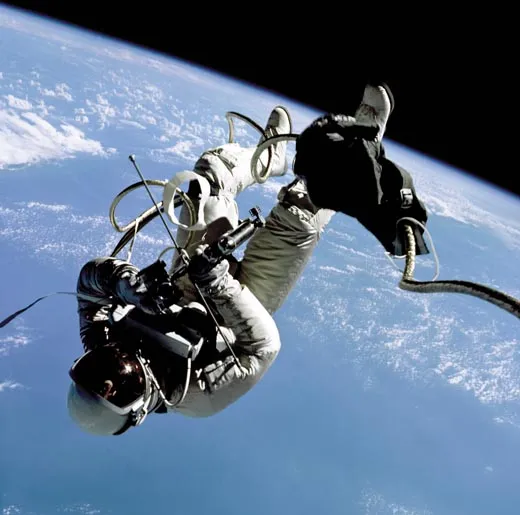
The first U.S. spacewalk, on Gemini 4 in June 1965, was surprisingly easy, almost playful at times. Mission control couldn’t hear Ed White very well—there was a problem with his microphone. So crewmate Jim McDivitt narrated the action while White drifted on his 25-foot tether and admired the view. When White planted his boots on the tiny spacecraft, McDivitt laughed, “You’re smearing up my windshield, you dirty dog.” White propelled himself with a little “zip gun” that fired compressed gas. He loved it—so much so that McDivitt had to badger him to come back inside. The whole thing lasted just 36 minutes. Gemini 9, on the other hand, was nearly a disaster. Gene Cernan worked so hard trying to get into an Air Force-built jet backpack called the Astronaut Maneuvering Unit that the exertion made his helmet visor fog up, and he had to cut the spacewalk short. Problems with this and later Gemini EVAs sent NASA back to the drawing board to redesign the suit and hatch and make other fixes. By the time of Buzz Aldrin’s three Gemini 12 outings in November 1966, EVA had become a science. Many of the spacewalking procedures in use today were developed during the Gemini program. NASA
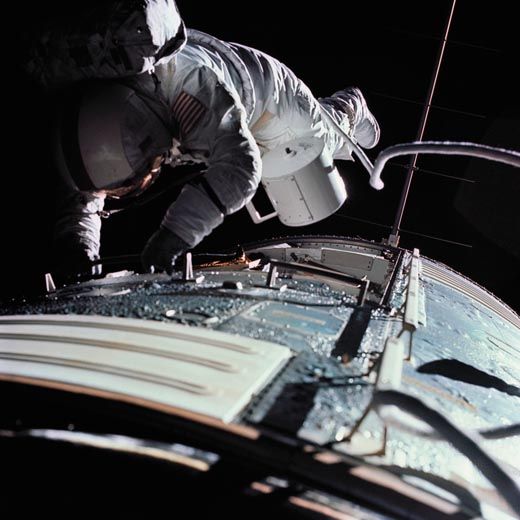
The “deep space EVA” may be the rarest of astronaut experiences. Only three people have done it: Al Worden on Apollo 15, Ken Mattingly on Apollo 16, and Ron Evans on Apollo 17 (pictured). A third of the way back from the moon, they climbed outside the command/service module to retrieve film that couldn’t survive entry into Earth’s atmosphere. For about an hour, each of the astronauts floated in deep space, tethered to their craft, 170,000 miles from Earth. On his Apollo 16 outing, Mattingly was at first troubled by not being able to see stars; then he opened his visor and was reassured. Years later he told an interviewer that experiencing that utter blackness was the only time during the moon voyage that he felt far from home. NASA

Moonwalking wasn’t like spacewalking; it had its own rules and rhythms. When astronauts bounded across the lunar surface, it was important to keep the heavy backpack’s momentum from getting away from them. The moonwalkers perfected a kind of loping run that worked well in low gravity, and though they occasionally fell down, no one was seriously hurt. (Clowning around on Apollo 16, Charlie Duke jumped four feet off the ground and landed flat on his back. “It was the only time in our whole lunar stay that I had a real moment of panic,” he wrote years later.) On the last three Apollo missions, the astronauts had a “moon buggy” that greatly extended their range and allowed much more ambitious geological fieldwork. In this photo, taken during the second Apollo 17 EVA in December 1972, Gene Cernan is more than five miles from his lunar lander—the farthest an astronaut ever strayed from a spacecraft. If their rover had broken down, NASA estimated Cernan and Jack Schmitt had enough oxygen and cooling water to make it back to the lander, walking at an average speed of 1.7 mph, or about 50 yards a minute. NASA
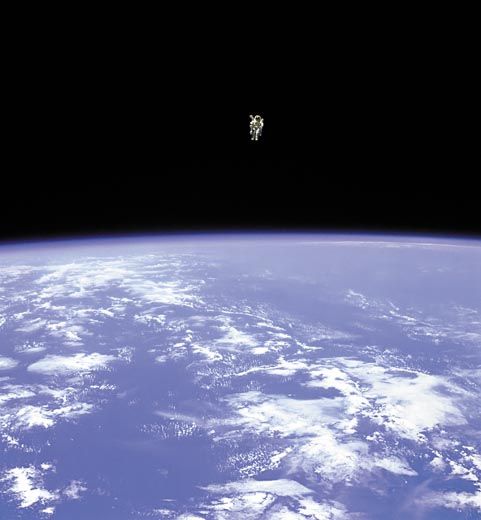
It was cold out there. All six space shuttle astronauts who flew the jet-powered backpack known as the Manned Maneuvering Unit (MMU) during their untethered spacewalks reported feeling chilled. Bruce McCandless (pictured here), who traveled farthest from the shuttle’s warm cargo bay—320 feet—cranked his spacesuit to the full “hot” position and left it there. The MMU cruised at three feet per second, propelled by blasts of nitrogen gas. It was fitting that McCandless was the first to fly it, on the 1984 shuttle mission STS 41-B. He had helped develop a predecessor device tested inside the cavernous Skylab space station in the 1970s. The MMU gave a smooth ride, but ultimately it was a technology without a mission; astronauts were able to reach anywhere they needed by other means. The MMUs were retired in 1984 after just three flights, although a small backpack called SAFER is still used during spacewalks as a backup to tethers. NASA
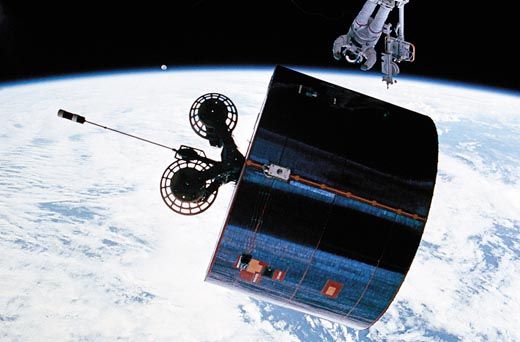
Even though large satellites are weightless in space, moving them around can be strenuous work. On STS-51-I in 1985, astronauts William Fisher and James van Hoften (pictured) repaired the 15,000-pound Leasat 3 satellite in the shuttle cargo bay. Then, van Hoften, nicknamed “Ox,” set the massive spacecraft spinning and released it with a shove into space. Back on the ground, he told debriefers, “Trying to do a translation [linear motion] and a rotation at the same time is a very difficult task, and 15,000 pounds is seven and a half tons. It’s big.” NASA
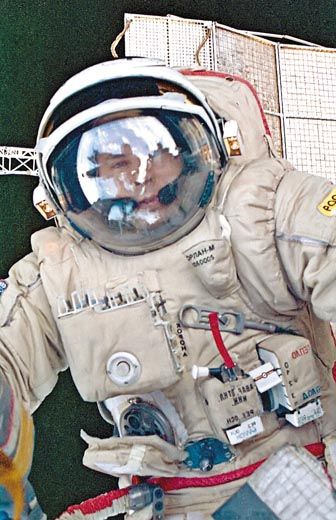
Following the first spacewalk by the Soviet Union in 1965, NASA dominated the practice of EVA for a decade; 38 of the first 40 spacewalks were American. But once the Soviets began building space stations—first Salyut in the 1970s, then Mir, then the core modules of the International Space Station—cosmonauts began racking up EVA hours maintaining the orbiting outposts. Anatoly Solovyev, shown here outside Mir in 1998, remains the world champion spacewalker, with 16 EVAs totaling 82 hours. NASA
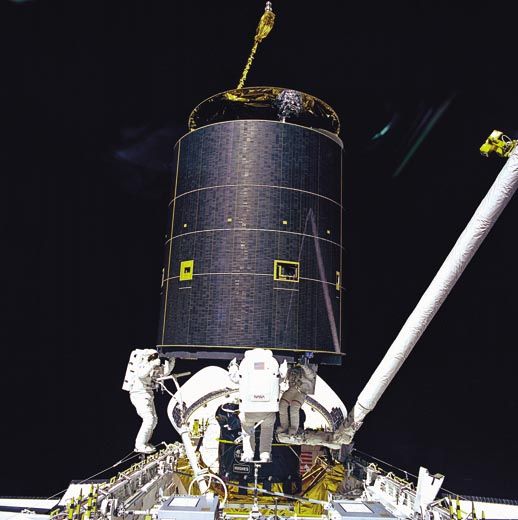
Before sts-49 in 1992, NASA had never sent three astronauts out on a spacewalk at the same time. It was the crew’s idea. When the original plan to secure the crippled Intelsat VI satellite failed—Pierre Thuot had tried to capture it while standing on the end of the shuttle’s robot arm—the crew improvised a scheme to send out Thuot, Rick Hieb, and Tom Akers to grab the slowly rotating satellite with their gloved hands. It worked. Then they attached a new rocket motor and sent the Intelsat on its way. Thuot said later, “Every time I watch the video from STS-49, I say, ‘God, I can’t believe we did that.’ ” NASA
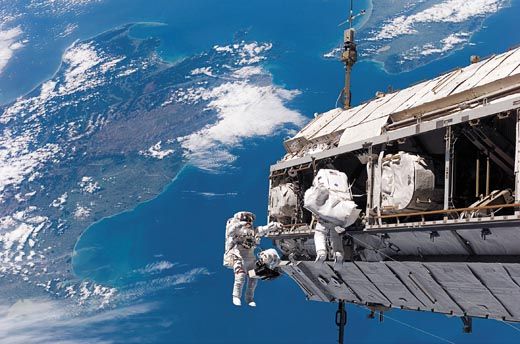
Before NASA started building the International Space Station in the late 1990s, agency engineers fretted publicly about the number of spacewalks that would be required to assemble the giant facility, which, when finished, will stretch 361 feet and weigh (if it were on Earth) 925,000 pounds. Critics thought the need for frequent, challenging EVAs could be a showstopper. Now, 123 successful spacewalks later, the astronauts have made the most complex assembly project in space history seem almost easy. The orbital construction workers have come from the United States, Russia, Europe, Japan, and Canada. Here, NASA’s Bob Curbeam (left) and Swedish astronaut Christer Fuglesang replace a camera on one of the station’s truss segments during STS-116 in 2006. Below them is New Zealand’s Cook Strait. NASA
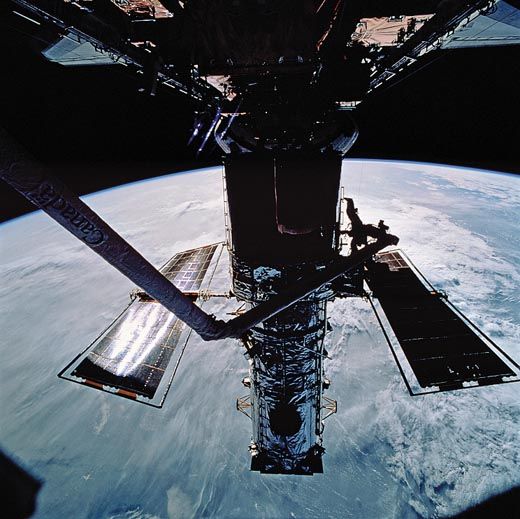
Without spacewalkers, the $1.6 billion Hubble Space Telescope would be known today as just a costly embarrassment. After it was launched on STS-31 in 1990, NASA discovered a flaw in Hubble’s mirror. Three years later, spacewalking astronauts installed a corrective optics system that restored the exquisite vision that has made the telescope one of the most productive scientific instruments in history. Luckily, Hubble had been designed to be serviced by astronauts. The orbiting observatory has required four more space shuttle missions to change parts and install newer, more capable cameras (pictured is Steve Smith on the second servicing mission, in 1997). NASA
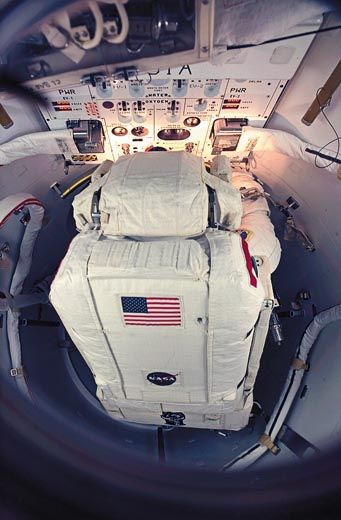
Astronaut Rick Mastracchio prepares to exit the space station’s Quest airlock to begin a spacewalk in August 2007. Airlocks serve as a buffer zone between a spacecraft’s shirtsleeve environment and the vacuum of space. Before an EVA, space-suited astronauts go inside the sealed chamber, air is pumped out, and they open the hatch to step outside. When they come back in, the process is reversed: Air is pumped back into the airlock before the spacewalkers open the inner hatch to rejoin their crewmates. Quest isn’t the station’s only airlock, but it’s the most spacious—so roomy, in fact, that astronauts spend the night in it before a spacewalk to acclimate to lower air pressure, flush nitrogen from their blood, and reduce the time they need to breathe pure oxygen before going outside. NASA
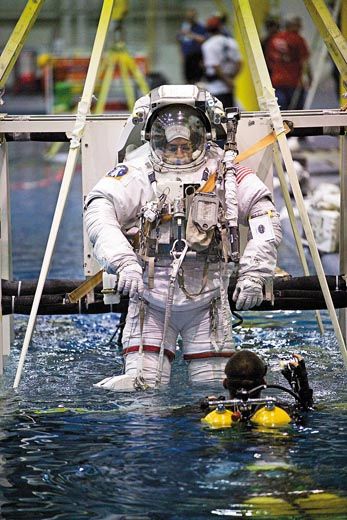
The six-million-gallon indoor pool at NASA’s Johnson Space Center in Houston goes by a prosaic name: the Neutral Buoyancy Laboratory. Since the days of Gemini, astronauts have used underwater training to rehearse the intricate choreography of an EVA—where and how to move, in what sequence, and on what schedule. Typically, a spacewalker in training, like Bill McArthur (seen here preparing for a 2005 mission), will spend 14 hours underwater for every hour he spends on an actual EVA. By the time astronauts head out the airlock, they’ve repeated the task so many times it has become second nature. NASA
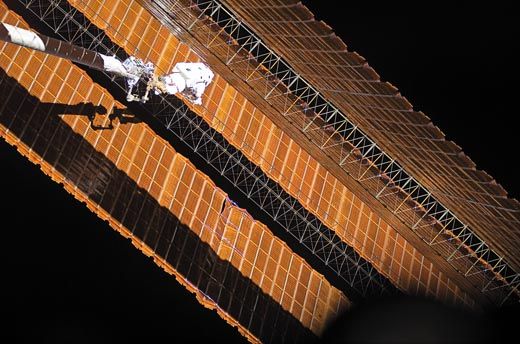
Spacewalkers do everything they can to minimize risk, but a certain amount of danger is unavoidable. On STS-120 in November 2007, a tear in the space station’s wing-like solar array needed repairing, and veteran spacewalker Scott Parazynski was the right man for the job. The tear was at a remote location on the giant complex, and required that the six-foot-two Parazynski be hoisted to the very limit of a 50-foot-long extension held by the shuttle’s 50-foot-long robot arm. A former surgeon, the astronaut made the repair while being careful to avoid electric shock and sharp metal that could tear his suit. Parazynski has an affinity for heights: Shortly after leaving NASA this spring, he set out to become the first astronaut to summit Mount Everest. NASA
Get the latest stories in your inbox every weekday.
Tony Reichhardt | READ MORE
Tony Reichhardt is a senior editor at Air & Space.